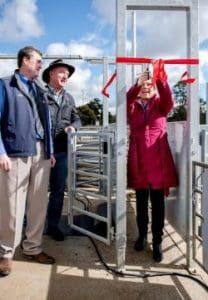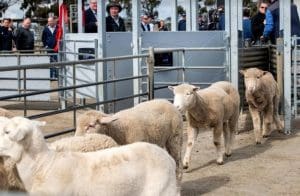
Victoria’s Minister for Agriculture Jaala Pulford ormally open the Bendigo saleyards EID scanning system with agents’ association president Rupert Fawcett, left, and Cr James Williams.
THE Bendigo saleyards’ new electronic sheep tag scanning system was formally opened by Victoria’s Minister for Agriculture Jaala Pulford last week.
The Bendigo Livestock Exchange was the last state saleyard to complete its EID installation and has been successfully scanning sheep and lambs through 12 Hamilton scanners mounted behind its drifting races.
Read rates have been achieved above the required 80 percent through its busy August period in several years. The exchange has averaged yardings of 22-23,000 a week recently, included 40,000 sheep and lambs in early August when the store lambs from New South Wales hit the market.
On Friday last week, Ms Pulford said it was her my pleasure to launch Bendigo’s new EID equipment and celebrate the way in which all stakeholders had worked together to transition to the electronic National Livestock Identification System (NLIS) for sheep and goats.
“It has been almost two years since I announced that Victoria would be the first state to transition to an electronic NLIS for sheep and goats.
“It was a decision I thought long and hard about, but ultimately decided in was the best decision I could make to ensure the future growth of our sheep and goat industry,” she said.
“The last two years have been significant for the Victorian sheep and goat industry as they have prepared for and implemented changes required under the electronic NLIS.
“The transition to an electronic NLIS is one the biggest reforms the Victorian Agriculture industry has seen in recent times and it has been introduced to protect our valuable livestock industries – industries which are integral to our rural and regional communities.”
EID system enables effective biosecurity traceback

Sheep running through the EID scanning system at the Bendigo saleyards.
Ms Pulford said with export products worth $6.7 billion per year and sheep and wool products worth more than $2.5 billion, electronic identification will provide the high level of traceability required to protect these valuable industries.
“Approximately 4.4 million sheep move through Victorian saleyards each year and the ability to be able to track animals quickly and accurately in the event of a serious animal disease or food safety event is paramount.
“Electronic identification allows us to do this effectively,” she said.
“Without saleyards coming to the table and being willing to work with us to find solutions this significant reform wouldn’t have been possible and the partnership has yielded some great results.
“I had the opportunity to visit the Hamilton Saleyards and see the ‘Hamilton Drafter’ in action. A real testament to the adaptability and ingenuity of our sector here in Victoria.”
Ms Pulford said the Andrews Labor Government has supported each of the state’s 22 sheep saleyards adapt to the new technology.
“We also supported everyone across the supply chain with a $17 million transition package, because we were committed to making this reform a success.
“All saleyards in Victoria have been scanning and recording data for all sheep and goats since 31 March 2018 – which is fantastic.”
Ms Pulford said there are not only biosecurity advantages of this reform but the benefits are more substantial than this.
“Knowledge is power.
“This technology gives producers, saleyards and others in the supply chain, the power to know and understand more about their livestock, providing opportunity and driving greater productivity.”
Ms Pulford said software developments have seen significant shifts in the way saleyards and livestock agents conduct their business, transitioning from pen and clerking books to tablet technology, removing a lot of the errors inherent with paper-based systems.
“I am confident we will continue to see improvements as industry leverages the technology across the supply chain to enhance their processes, systems and decision-making.
“Victoria took the lead on transitioning to the electronic identification of sheep and goats to provide trading partners with increased confidence in the safety and origin of Victorian products,” she said.
“Everyone continues to have a significant role to play in this transition – every producer, every saleyard, every agent.”

HAVE YOUR SAY